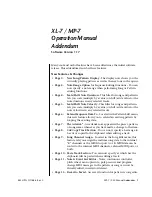
LBM
V0815
35
Nederlands
English
Deutsch
Français
User guide
The following recommendations for safe working procedures are given as an example, on top
of all information characteristics of this machine.
When working with the machine, safety equipment must be used.
Nevertheless, the user must also follow the operating instructions to avoid accidents.
Training of the machine operators
It is absolutely essential that the machine operator receives thourough training regarding operating
and adjusting the machine.
In particular:
The risks involved in working with the machine;
The operating principles, the correct usage and adjustment of the machine;
The correct choice of the tool for each operation;
The safe handling of the parts to be processed;
The position of the hands in relation to the turning parts;
Storing the workpieces safely before and after machining them
Stability of the machine
In order to use the machine safely, it is essential to place it stable on the ground.
Adjustment and installation
Disconnect the machine from the power supply before every adjustment.
The recommendations of the machine manufacterer must be followed when adjusting and
installing the tools.
The tools must be suited to the material being cut to assure safe and efficient working.
The tools must be correctly sharpened and installed.
Handling of tools
Danger of getting hurt by very sharp cutting edges exist, when touching the tool.
Be cautious when unpacking or packing as well as handling.
Do not touch tools at the cutting edges.
Wear of safety gloves when handling tools in your workshop.
Always put the tools on soft supports.
Transport clamping adaptors and tools only in a suitable packing.
Machine handling
• Choose for each action the most appropriate safety devices.
• Do not remove chippings, cuttings, dust and waste of wood or particle board by hand.
Reasons for tool rupture
The following reasons may lead to a tool rupture:
• Grinding cracks or change of the cutting geometry due to improper sharpening.
• Jerky movevements of the work-piece.
• Jam of tool by waste piece.
• Overheating by friction due to too small feed rate or too small cutting depth as well as due to
dull cutting edges.
• Too high feed rate.
• Too large cutting depth.
• Insufficient clamping of the tool.
• Vibrations of the machine.
Operation
• Danger of injuries or danger of crushing by the rotating tool.
• Do not touch the rotating tool.
• Do not slow down the tool by lateral pressure against the body.
• Do not work without the necessary safety guard.
Summary of Contents for LBM
Page 16: ...16 V0517 LBM ...
Page 28: ...28 V0517 LBM Nederlands Français English Deutsch Fig 4 Fig 5 Fig 6 ...
Page 59: ...LBM V0517 59 ...
Page 60: ...60 V0517 LBM ...
Page 61: ...LBM V0517 61 ...
Page 62: ...62 V0517 LBM ...
Page 63: ...LBM V0517 63 ...
Page 64: ...64 V0517 LBM ...
Page 65: ...LBM V0517 65 ...
Page 66: ...66 V0517 LBM ...
Page 67: ...LBM V0517 67 ...
Page 68: ...68 V0517 LBM ...
Page 69: ...LBM V0517 69 ...
Page 70: ...70 V0517 LBM ...
Page 71: ...LBM V0517 71 ...
Page 72: ...72 V0517 LBM ...
















































